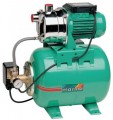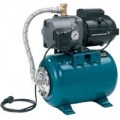Maximum performance
The maximum volume of water that the device can pump in a certain amount of time. It is one of the key specs of any pump because characterizes the volume of water with which the device can work. At the same time, it does not always make sense to pursue maximum performance — after all, it significantly affects the dimensions and weight of the unit.
Some formulas allow you to derive optimal performance values for different situations. So, if the pump is designed to supply water to water intake points, its minimum required performance should not be lower than the highest total flow rate; if desired, a margin of 20-30% can be added to this value. And for sewer models (see "Suitable for"), everything will depend on the volume of wastewater. More detailed recommendations for choosing a pump depending on performance can be found in special sources.
Maximum head
The maximum head generated by the pump. This parameter is most often indicated in meters, by the height of the water column that the unit can create — in other words, by the height to which it can supply water. You can estimate the pressure created by the pump using a simple formula: every 10 m of head corresponds to a pressure of 1 bar.
It is worth choosing a pump according to this parameter, taking into account the height to which it should supply water, as well as adjusting for losses and the need for pressure in the water supply. To do this, it is necessary to determine the difference in height between the water level and the highest point of water intake, add another 10 to 30 m to this figure (depending on the pressure that needs to be obtained in the water supply), and multiply the result by 1.1 — this will be the minimum pressure required.
Max. pressure
The highest pressure that the pump is capable of creating during operation. This parameter is directly related to the maximum head (see above); however, it is less obvious, and therefore, it is indicated rarely.
Suction height
The largest difference between the height of the pump and the height of the water level at which the pump can provide normal suction. Without special devices, the maximum value of this parameter is 7-8 m — this is due to the physics of the process. However, when using an ejector (see below), the suction height can be increased several times.
Maximum liquid temperature
The highest temperature of water at which the pump is capable of operating normally. Usually, in most models this parameter is 35-40 °C — at high temperatures it is difficult to ensure effective cooling of the engine and moving parts, and in fact, such conditions are rare.
Volume of water pressure tank
The volume of the water pressure tank provided in the design of the pressure tank unit.
A water pressure tank is a reservoir capable of holding a certain volume of water. It performs several functions at once. The main ones are: firstly, maintaining a stable pressure; secondly, protection against water hammer; and thirdly, storage of an “emergency” supply of water in case of a power outage, pump breakdown, etc. The larger the volume of this tank, the better it handles its capabilities; on the other hand, a large capacity significantly affects the dimensions and cost of the tank. Therefore, it does not always make sense to look for a pump with the maximum volume of the water pressure tank. Specific recommendations on choosing the optimal volume for different situations can be found in special sources.
Maximum power
Rated power of the pump motor. The more powerful the engine, the higher the performance of the unit, usually, the greater the pressure, suction height, etc. Of course, these parameters largely depend on other features (primarily the pump type, see above); but models similar in design can be compared in terms of power.
Note that high power, usually, increases the size, weight and cost of the pump, and also implies high costs of electricity or fuel (see "Power source"). Therefore, it is worth choosing a pump according to this parameter taking into account the specific situation; more detailed recommendations can be found in special sources.
Protection class (IP)
An indicator that determines the degree of protection of dangerous (moving and current-carrying) parts of the hardware of the pump from adverse effects, namely solid objects and water. Since pumps, by definition, are used for pumping liquids, and many of them can normally pass quite large particles, in this case, we are talking about protection against moisture and foreign objects from outside.
The level of protection is usually indicated by a marking of the letters IP and two numbers, the first of which indicates protection against the effects of solid objects, and the second — against the ingress of water.
For the first digit, each value corresponds to the following protection values: 1 — protection against objects with a diameter of more than 50 mm (large body surfaces) 2 — against objects with a diameter of more than 12.5 mm (fingers, etc.) 3 — against objects more than 2.5 mm (most tools) 4 — against objects larger than 1 mm (virtually all tools, most wires) 5 — dust-proof (total protection against contact; dust can enter, but does not affect the operation of the device) 6 — dust-proof (case with full dust protection and contact).
For the second digit: 1 — protection against vertically falling drops of water 2 — against drops of water with a deviation of up to 15° from the vertical axis of the device 3 — against drops of water with a deviation of up to 60° from the vertical axis of the device (rain) 4 — against splashes from any direct...ion 5 — from jets from any direction 6 — from sea waves or strong water jets 7 — short-term immersion to a depth of up to 1 m (without the possibility of continuous operation in immersed mode) 8 — long-term immersion to a depth of more than 1 m (with the possibility of permanent operation) in immersed mode).
Note that in some cases one of the numbers can be replaced by the letter X — this means that official certification for the corresponding parameter has not been carried out. In pumps, X is usually put in place of the first digit, because. a high degree of moisture resistance (and for submersible models, for example, it must, by definition, correspond to 8) means a high degree of protection against solid contaminants.
Country of origin
Country of origin of the brand under which the pump is marketed.
There are many stereotypes related to how the origin of goods from a particular country affects their quality. However, these stereotypes are unfounded. Firstly, this paragraph does not indicate the actual place of production of the unit, but the "homeland" of the trademark (or the location of the manufacturer's headquarters); production facilities may be located in another country. Secondly, the actual quality of the product depends not so much on geography, but on the organization of processes within a particular company. So when choosing, it is best to focus not so much on the "nationality" of the pump, but on the overall reputation of a particular brand. And paying attention to the country of origin makes sense if you fundamentally want (or do not want) to support a manufacturer from a certain state.

